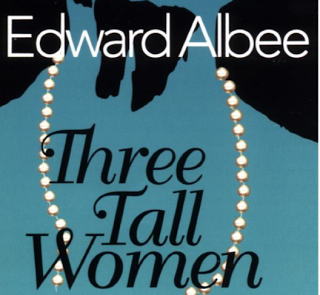Edward Albee’s Three Tall Women is a play that explores the generational differences of femininity in the form of three women. who are very different from one another, yet come from the same entity. The play revels largely in the aspect of nostalgic and self-reflection and connects these women through the juxtaposition of the various personality traits that are reflected through their dialog. Their dialog also exposes various cultural and generational differences as they come to terms with how they lived their lives and how it's affecting them in their current state.
Albee only explicitly differentiates these women by way of naming them ‘A’, ‘B’ and ‘C’. Though they are initially introduced as separate characters, in Act II, they are then suddenly transformed into different stages of the life of one woman, namely 'A', whose character does not change in the second act. ‘A’ shines as a main protagonist in the work as a bitter, old, senile woman. Though her speech is riddled with the repetition of various phrases that tie into the harsh realities of the time in which she lived, they are not an inorganic in nature as it is subtly revealed that A is struggling with Alzheimer’s and ‘B’ is supposedly her caretaker. A majority of the play involves ‘A’s recapping events of her life. Whether her dated views are seething in “arrogant complacency [or] fearful disorientation” (Brantley), they all have something to reveal about ‘A’, whether she would like them to or not. Not only does her blunt and complacent homophobia and racism mark her as more as a product of the time in which she was born, but her ambitions revolving marriage and love do as well. If I don’t have my eye out, who will” (Three Tall Women 25), she states in relation to finding a husband. The reason behind why she is like this is revealed later on she mentions the way her mother groomed her to be this way. The harsh-and-less-than-politically-correct ideologies that were preached to women in time were hard to shake and ‘A’ is just one example of just how deeply ingrained they got. However, while ‘A’ reflects the older generation and how things were, ‘B’ and ‘C’s reactions these statements reveal a lot about them as well, especially in relation to how their views differ greatly from ‘A’s because of when they grew up.
Though ‘C’ is initially introduced as a fruitful young lawyer, ‘C’ also represents the youthfulness, innocence, and naivete of a young woman trying to navigate the real world for the first time at the age of 26. She’s curious, not only about ‘A’s past and how she came to be, but in the future as well as how she’ll avoid becoming like her. She’s impatient with ‘A’s traditionalist, intolerant views on race and sexuality and often challenges them, which is on par with that of many millennial dialogues that occur when intolerance is involved. And even more so, she has a deep-seated fear of morality which directly reflects the same views that a lot of young millennials today have (Boyanton). Though Albee was probably not trying to reflect a modernist society in ‘C’s character, as times have changed vastly since the 60’s when the play was initially released, Albee captures the universal essence of youth, naivete and the strive for individualism and most people that are ‘C’s age tend to have.
‘B’ stands in as not only ‘A’s caretaker, but as a referee between both ‘C’ and ‘A’ as she simultaneously reprimands ‘A’ for her intolerance while calmly reminding ‘C’ of ‘A’s senility and of the fact that she is what ‘C’ is going to become, regardless of whether or not she wants to or not. Though she’s not much different from both ‘A’ or ‘C’, she represents a calmer median between the two. She is much more mature, educated and accepting of the future than ‘C’ and she is more more rational and coherent and less cynical than ‘A’ more than ‘C.”
What I like most about being where I am is that there’s a lot I don’t have to go through anymore, and that doesn’t mean closing down - for me, at any rate...Standing upright on top of the middle has to be the happiest time (Three Tall Women 54). ‘B’ is at the point where she doesn’t have to experience much because she already knows what’s to come which allows her to enjoy the good things that happen to her, without living with the sense of regret and disdain that ‘A’ allows to dampen her existence, regardless of what age she’s living in.


